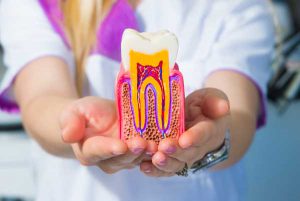Root Canal Treatment Stafford, UK
Root Canal (Endodontic treatment) procedures involve treating infections inside teeth by removing infected tissue from within them.
A 'Root canal' treatment with the correct numbing agent should not be painful and can save a tooth that might otherwise have to be removed completely.

Endodontic Dental Treatment
If the nerves inside a tooth has died because of decay, extensive damage, or trauma, root canal therapy may be necessary. The purpose of the treatment is to remove the infected tooth nerve including the tissue inside the root of the tooth itself and during the same procedure; to seal the root canal system to preserve the tooth & thus prevent future complications or discomfort.
Root canal treatment is often carried out under local anaesthetic combined with a rubber dam (a small rubber sheet) which protects the patient and at the same time provides a clean working area. Often a Root canal treatment is carried out over more than one appointment, and if necessary a crown is usually recommended following treatment in order to protect the tooth from fracture.
Root Canal Dentist Stafford: St Marys Dental Practice +44 1785 251287
Why is 'Root Canal' needed?
The infection at the centre of a tooth (the root canal) is caused by bacteria that live in the mouth and invade the tooth.
-
Tooth Decay
Removal of the damaged pulp tissue and refill the tooth with a biocompatible substance
-
Leaky Fillings
A leaky filling is a filling that doesn't fit snugly against your tooth on all sides
-
Damage following repeat repair
When a tooth has already been repaired but over time this repair has failed a root canal maybe necessary to save the tooth.
-
Crack or Chip in tooth
Often when this happens, damage is caused to the tooth's root & in some cases the only option is a root canal treatment

Frequently Asked Questions
First we have to remove the bacteria from inside the tooth, then clean out the infected pulp chamber. This can either be accomplished by removing the bacteria from your root canal system (root canals) or removing the tooth (extraction).
But removing the tooth usually isn't recommended as it's better not to remove too many of your natural teeth. After the bacteria have been removed and the root canal is filled, the tooth is sealed with a filling or a crown. In most cases, the inflamed tissue near your tooth will heal naturally.
Before having root canal treatment, you'll usually be given a local anaesthetic This means the procedure should be painless and no more unpleasant than having a filling.
Root canal treatment is quite successful. In about 9 out of 10 cases a tooth can survive for up to 10 years after its had a root canal treatment.

